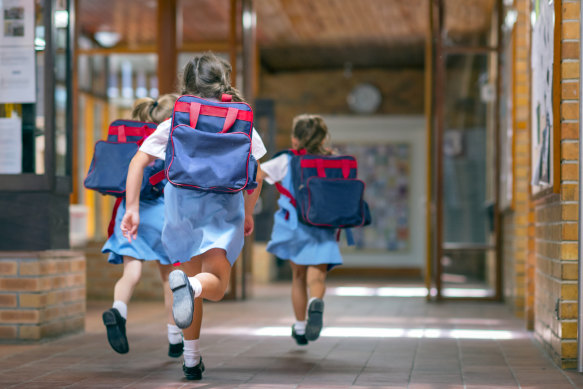Four new Catholic primary schools, a new school campus, and upgrades to 13 Catholic and low-fee independent schools have been promised by Premier Daniel Andrews in an election funding pledge valued at $717 million over four years.
The announcement focuses on Victoria’s growth areas, particularly in the west and north-east of Melbourne, with two new schools and an upgrade promised in the key state election seats of Yan Yean and Melton.
Independent and Catholic schools will receive hundreds of millions in new funding if Labor is re-elected in the November state election.Credit:iStock
Federal seat McEwen, which covers state seat Yan Yean, had a -2 per cent swing against Labor in this year’s federal election. Similarly, the federal electorate of Hawke, which covers Melton, had a -2.59 per cent swing against the ALP.
Of the funding, $450 million will go towards building and upgrading Catholic and independent schools across the state, with Catholic schools receiving at least 70 per cent of the investment, in line with their share of students.
Andrews said the Melbourne Archdiocese has promised to match the Catholic school funding by 20 per cent.
“A third of families send their kids to low-fee Catholic schools and other low-fee independent schools and choice has always been a really important part of our education system,” he said. “We know if we step in … that means parents pay lower fees.”
New schools promised in 2025/2026:
- New campus of Kolbe College, Donnybrook Road, Mickleham (Craigieburn Parish)
- New Catholic Primary School, Wollert (Epping Parish)
- Holy Trinity Primary School, Sunbury (Sunbury Parish)
- Mary, Queen of Heaven Primary School, Greenvale (Roxburgh Park Parish)
- St Lawrence of Brindisi Primary School, Weir Views (Melton South Parish)
Where possible, the government is also promising $250 million to build and upgrade about 60 kindergartens at Catholic and independent schools to allow for smooth drop-off for families with multiple children and to ensure all non-government kindergartens receive the standard non-government school rate of $3831 per enrolment.
The Smile Squad free dental van will also visit low-fee independent and Catholic schools from 2026 – saving on trips to the dentist – thanks to a $17 million pledge to expand its services.
In early October, the opposition promised $700 million over four years for Catholic and non-government schools.
The opposition’s education spokesman, David Hodgett, said Labor’s new funding announcement was “very similar to ours”.
Labor’s promised upgrades/extensions:
He said his party’s funding would likely include upgrades to Catholic and non-government kindergartens as well and be guided by the needs of Catholic and independent schools in growth areas but wouldn’t be limited to low-fee schools.
About 30 per cent of Victoria’s students attend a non-government or Catholic school, Hodgett said.
“Non-government schools continually tell us [that] if they didn’t exist, you’d have to accommodate all these children into the public school system. We believe in choice, we should be investing in capital works and what goes on inside the schools,” he said.
Deb James, general secretary of Independent Education Union Victoria, said while additional investment in infrastructure for low-fee schools was welcome, schools were more than just buildings. The union is campaigning for a new four-year agreement for teachers, which includes a two per cent annual pay rise and time-in-lieu increases for extracurricular duties such as camps.
“What’s really disappointing is the failure of Catholic [school] employers to step up with investment in their employees,” she said.
“Urgently needed workload improvements have been agreed in government schools and some Catholic schools, yet other Catholic employers are happy to accept government investment while seeking to lock in second-rate employment conditions for their hard-working staff.”
Education economist Adam Rorris said non-government schools have consistently overspent public schools for more than 10 years and the government’s first obligation should be to public schools.
“I would have thought any additional expenditure would be given entirely to public schools given how far behind they are,” he said.
Rorris said to divert such a high percentage of education funding to non-government schools didn’t make sense.
“It sounds like a political decision, for obvious reasons. I can’t see how it stacked up from an education needs-based funding point of view.”
The Morning Edition newsletter is our guide to the day’s most important and interesting stories, analysis and insights. Sign up here.
Most Viewed in National
From our partners
Source: Read Full Article
